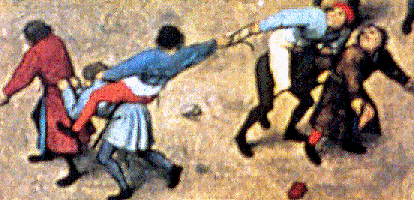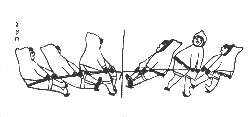
There are a number of games with this title. It's origins are in primative times. Scholars indicate that before the middle ages it was used by some people in a rite to depict "a struggle between good and evil".
In the version of the game depicted in Brueghel's Painting, there are two teams. One person from each team is the "head" of a horse or other animal. A second person on each team takes the part of the "body" of the animal. The "body" is attached to the "head" by the second team member holding the belt of the first team member. A third team member sits on the back of the second team member - much like a person riding a horse. The "rider" on each team holds on to one end of a belt, pieces of rope, or leather thong. At a signal, the game starts, and each team tries to unseat the "rider" of the opposing team.

In some cultures teams form two opposing lines. A long rope is used which each team member holds on to. A line is drawn on the ground or a stake is placed to indicate the midpoint, or a knot is tied in the midpoint of the rope. The midpoint of the rope is placed across the line or at the stake. One team tries to "tug" the opposing team across the line or beyond the stake. The picture to the right is from the Inuit Culture, in which many tug of war games are played. To see more Inuit "Tug of War" games CLICK the picture or or the menu item in the left pane. Use your "back button" to return to this page.
A 19th Century Hawaiian "Tug of War" game can be viewed by CLICKING on the appropriate item in the left menu above.
Last update February 10, 2010